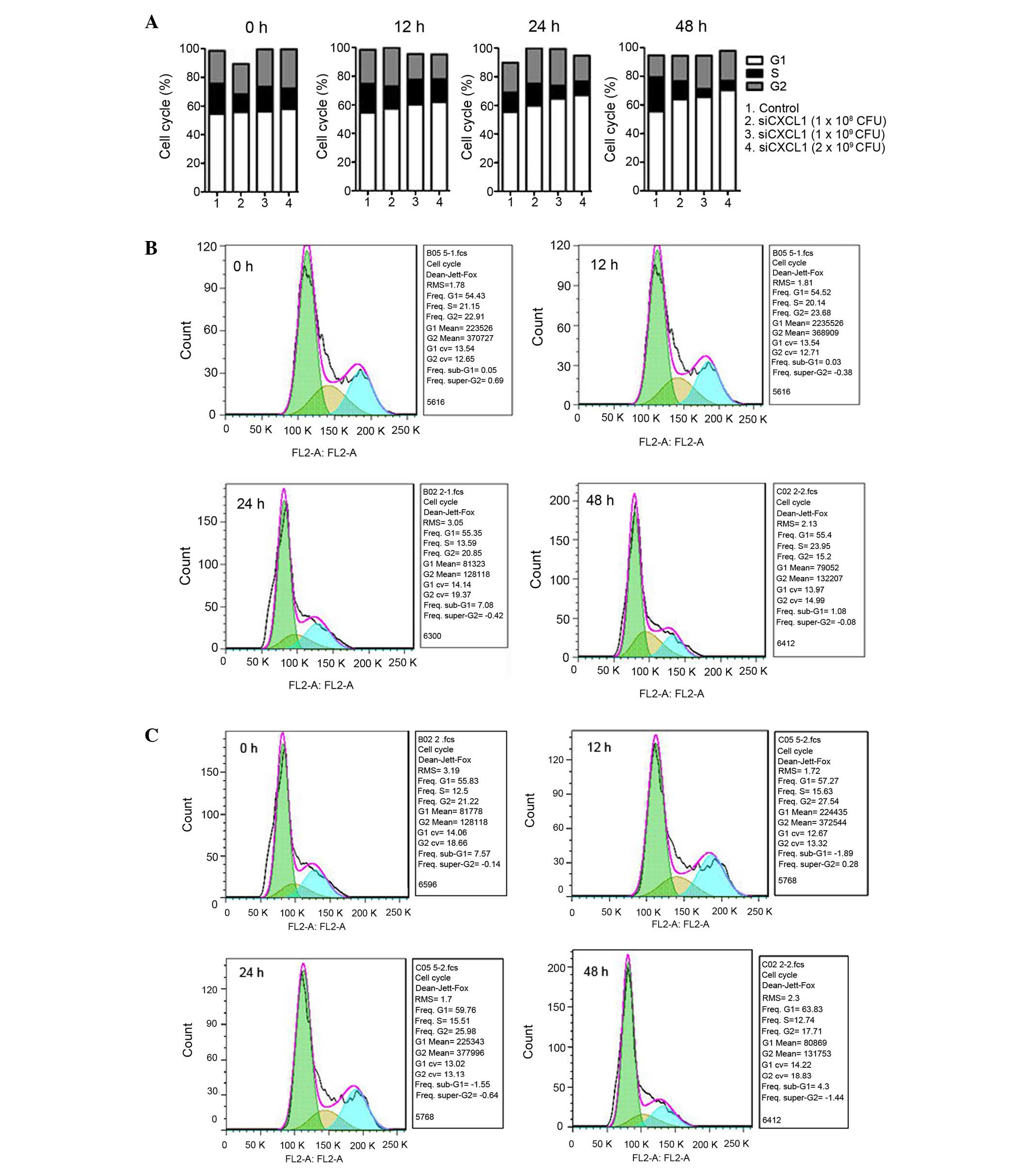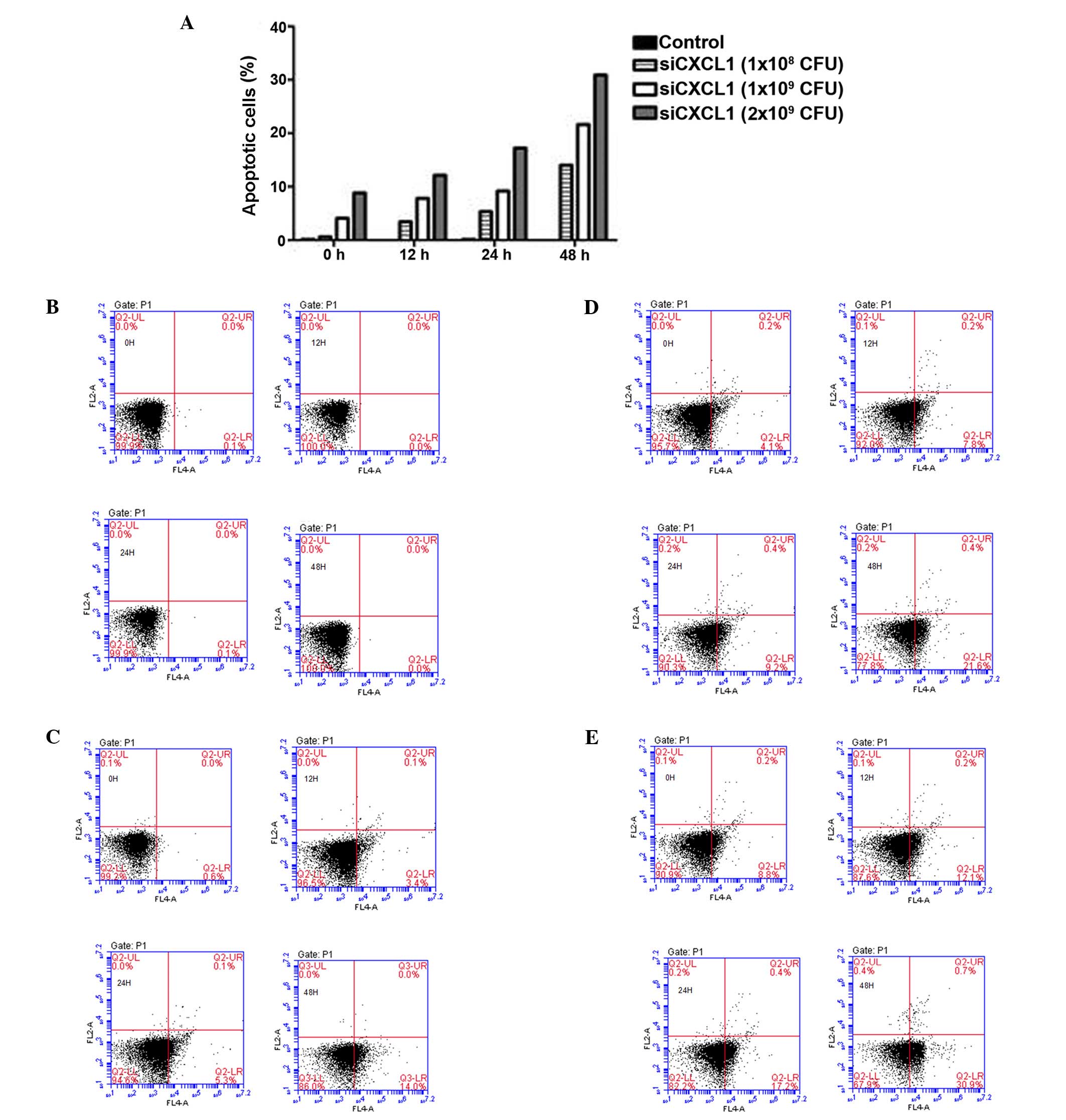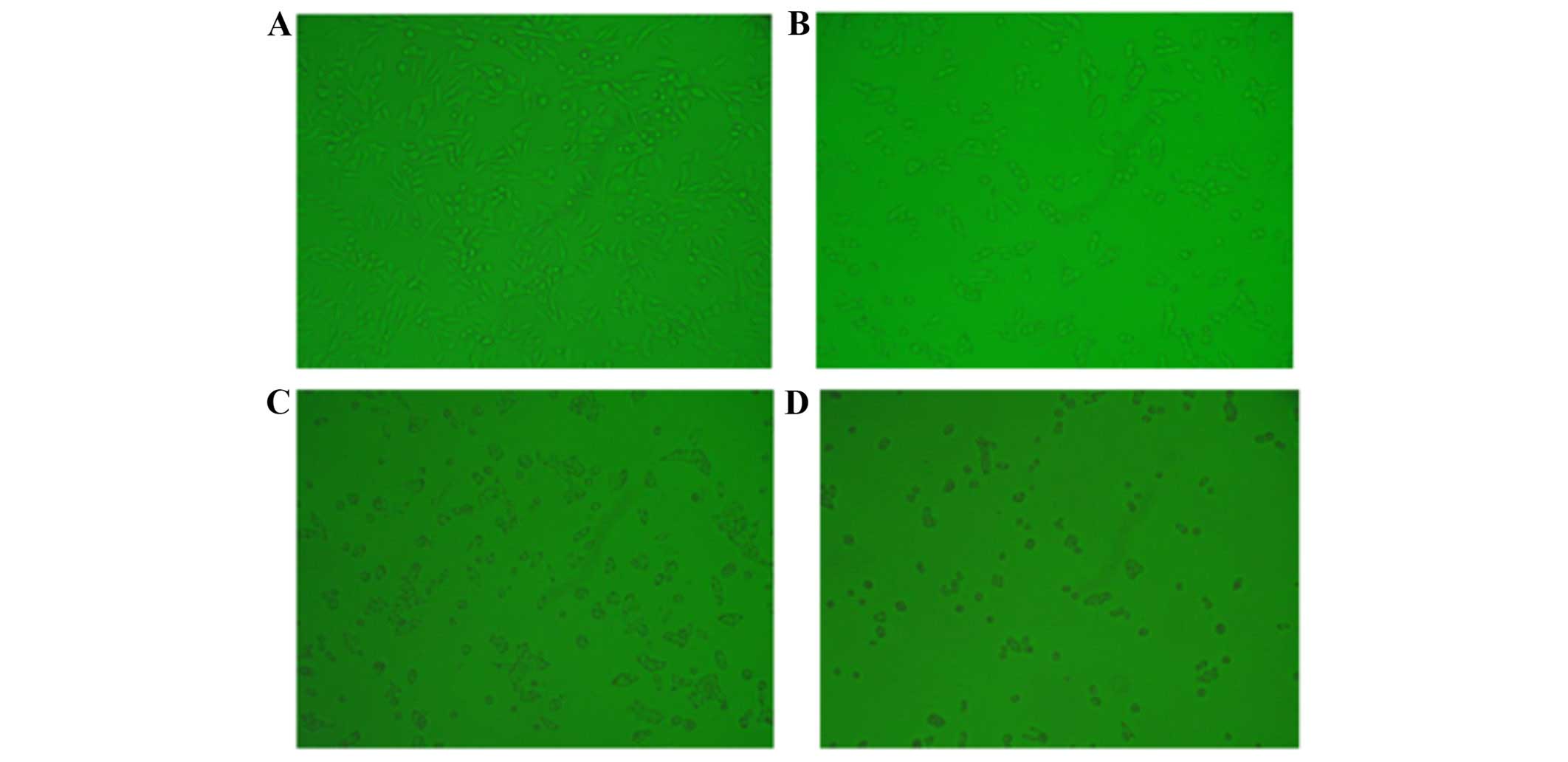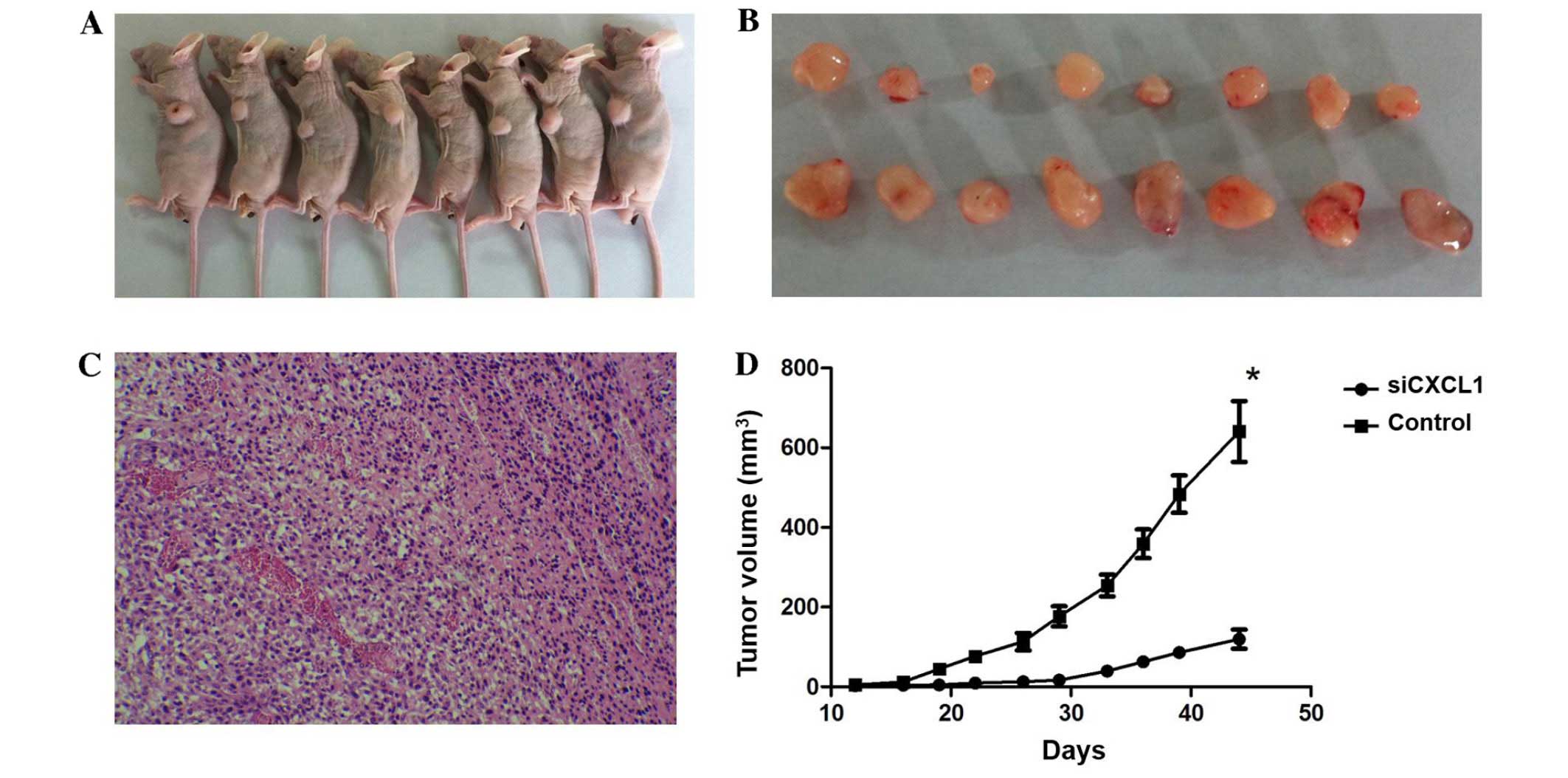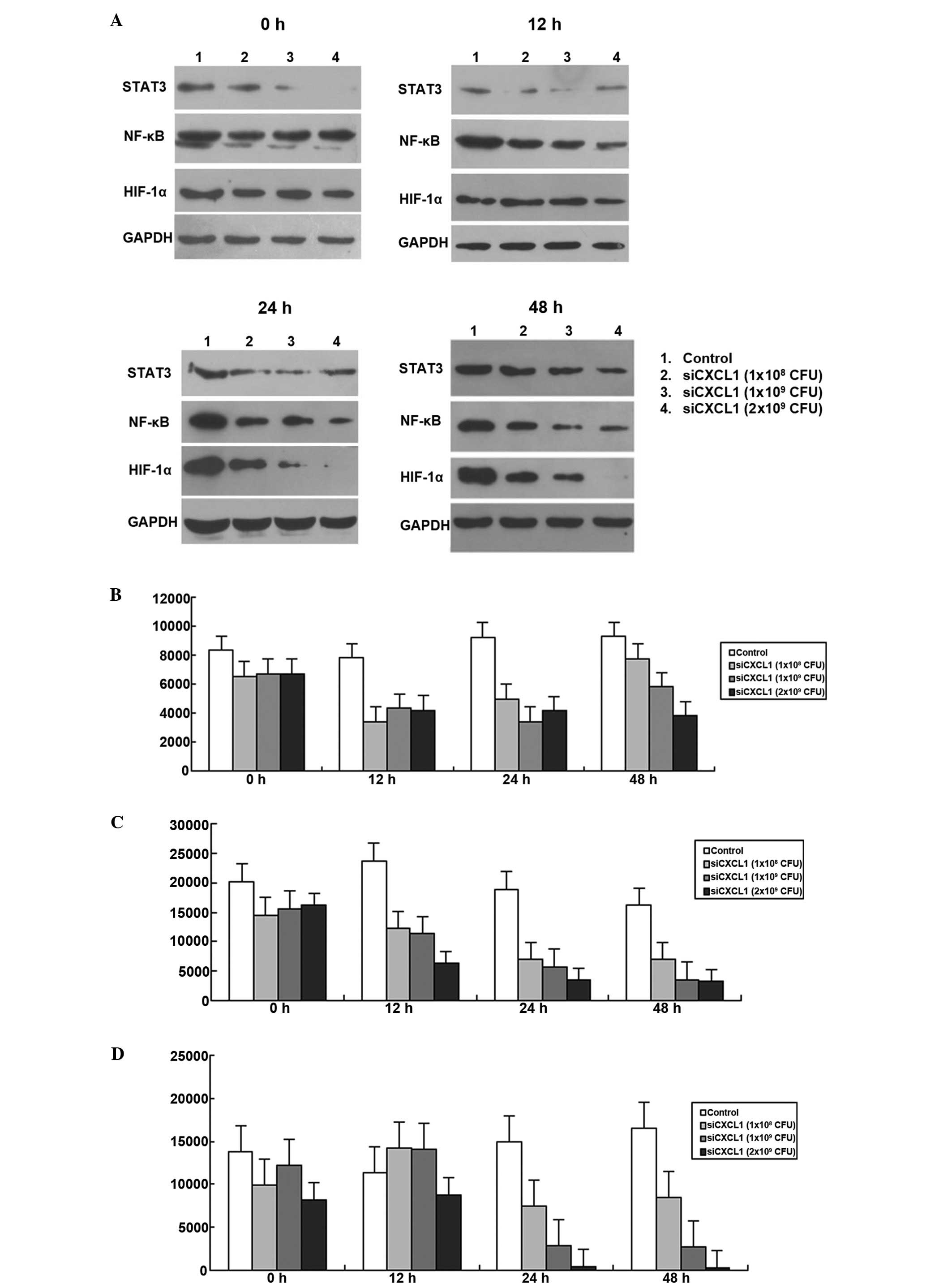Targeted silencing of CXCL1 by siRNA inhibits tumor growth and apoptosis in hepatocellular carcinoma
- Authors:
- Published online on: October 13, 2015 https://doi.org/10.3892/ijo.2015.3203
- Pages: 2131-2140
Abstract
Introduction
Hepatocellular carcinoma (HCC) is one of the most common cancers worldwide and a major cause of cancer-related mortality (1). At the time of diagnosis the majority of patients is in late stage, the overall survival for HCC patients have also been challenged (2). Studies have showed that chemokine and chemokine receptors play important roles in proliferation and apoptosis of the HCC cells (3–6). Identification of these chemokine receptors may provide potential targets for use in HCC therapy. However, whether CXCL1 participates in proliferation and apoptosis of HCC is yet unclear. Here, we report our findings on gene expression of the pro-angiogenic subgroup of chemokines, the CXCL chemokines. Apart from their pro-angiogenic function, these chemokines appear to also contribute to tumor cell growth and apoptosis. In our nude mouse model of HCC, we found CXCL1,2,3 and IL-1β to be upregulated in the tumor tissue as compared to the peritumor tissues (7).
Chemokine (C-X-C motif) ligand 1 (CXCL1), binding to the G protein-coupled chemokine receptor CXCR2, is involved in fibrogenesis and angiogenesis, except for the role in inflammation and recruitment of neutrophils (8–10). CXCL1 is upregulated in some types of human cancer, including colorectal, bladder, prostate and skin cancers (11–14). A previous study revealed that CXCR2 was overexpressed in HCC, especially in advanced stage (15).
Most inflammatory signals promote tumorigenesis through NF-κB and STAT3 activation, both in cancer and stroma cells (16). NF-κB and STAT3 orchestrates the trafficking of immune and inflammatory cells to sites of inflammatory by upregulating chemokines, which in turn further activate STAT3 signaling (16–18). Chemokines act in an autocrine and a paracrine manner to promote cancer proliferation, invasion, and migration (8,16,18). Upregulated chemokines are expressed in a wide range of human cancer, and associated with a poor prognosis and resistance to therapy (8–11,18).
Until now, there is no study yet regarding the function of CXCL1 in HCC. In the present study, the corresponding molecular mechanism after CXCL1 knockdown using a recombinant lentiviral vector expressing small interference RNA (siRNA) for CXCL1 was also examined. RNA interference (RNAi)-mediated knockdown of CXCL1 in CBRH-7919 cells significantly inhibited the proliferation and induced apoptosis of the cell line in vitro and in vivo. These results provide new evidence of CXCL1 as a promising tumor gene therapeutic target.
Materials and methods
HCC cell line
The human HCC cell line CBRH-7919 (Chinese Academy of Sciences Cell Bank, Shanghai, China) was used in this study. Cells were cultured at 37ºC in a humidified atmosphere with 5% CO2 in Dulbecco's modified Eagle's medium (DMEM; Gibco BRL, Rockville, MD, USA) supplemented with 10% fetal bovine serum (FBS) (Life Technologies, Carlsbad, CA, USA), 100 mg/ml penicillin G, and 50 μg/ml streptomycin (Life Technologies).
Quantitative real-time PCR (qRT-PCR)
Total RNA was isolated by TRIzol (Invitrogen, Carlsbad, CA, USA) according to the manufacturer's instructions. Total RNA quality was assessed using Agilent 2100 Bioanalyzer (Agilent Technologies, Inc., Santa Clara, CA, USA), and its concentration was measured by using Nanodrop 2000 spectrophotometer (Thermo Fisher Scientific, Wilmington, DE, USA). RNA was converted to cDNA using the RevertAid First Strand cDNA Synthesis kit (Thermo Fisher Scientific, Waltham, MA, USA). The level of CXCL1 mRNA expression was evaluated by qRT-PCR. The following primers were used for qRT-PCR: CXCL1, 5′-TAGAAGGTGTTGAGCGGGAAG-3′ (sense) and 5′-TGAGACGAGAAGGAGCATTGG-3′ (antisense); GAPDH, 5′-GTCGGTGTGAACGGATTTG-3′ (sense) and 5′-TCCCATTCTCAGCCTTGAC-3′ (antisense). qRT-PCR was performed using DyNAmo ColorFlash SYBR-Green qPCR kit on an ABI 7300 system (Applied Biosystems Life Technologies, Foster City, CA, USA).
RNAi
The siRNAs against CXCL1 were designed and ordered from Shanghai GenePharma Co., Ltd. (Shanghai, China). CBRH-7919 cells were transfected with the siRNAs using Lipofectamine RNAiMax (Invitrogen) according to the manufacturer's instructions. Cells were incubated for 48 h, and knockdown efficiency was determined by both qRT-PCR and western blot analysis. The siRNA with the sequence 5′-GTCTCAGGACAGAGAAGTT-3′ showed the highest efficiency in the knockdown of CXCL1 and was used in this study.
Cell proliferation assay
Cell proliferation assays were conducted using Cell Counting Kit-8 (CCK-8; Dojindo Laboratories, Kumamoto, Japan). When cells were plated in 96-well plates at 1×104 cells/well and incubated for 5 days. Ten microliters of CCK-8 solution was added to each well daily and were incubated for another 2 h. The value of optical density was measured at a wavelength of 450 nm using a microplate reader (Varioskan Flash 3001; Thermo Fisher Scientific, Marietta, OH, USA). The amount of the formazan dye generated by the activities of dehydrogenases in cells is directly proportional to the number of living cells. Also, the plate colony formation assay was performed to evaluate the colony formation ability of cells. The tumor cells were cultured at 1,000 cells/5 ml with DMEM and 10% FBS in a 6-well plate. After 10 days in culture, the cells were fixed with methanol for 10 min and stained with 1% crystal violet solution for 20 min to visualize colonies for counting.
FACS analysis for G0-G1 phase arrest and apoptosis
For cell cycle analysis, CBRH-7919-controls and CBRH-7919-shRNA were labelled with propidium iodide using a Cycle TEST™ PLUS DNA reagent kit (BD Pharmingen, San Diego, CA, USA), and then analyzed by FACScan flow cytometer (BD Biosciences, San Jose, CA, USA) according to the manufacturer's guidelines. For apoptosis analysis, cells were stained with Annexin V-FITC and propidium iodide and quantified by FACScan flow cytometer (both from BD Biosciences). All experiments were performed in triplicate.
TUNEL assay
Apoptosis assay was performed using Apo-Direct TUNEL Assay kit (Millipore Corp., Billerica, MA, USA). Cells were harvested and fixed in 4% PFA for 60 min at 4ºC, followed by a second fixation in 70% (v/v) ethanol overnight at −20ºC. Cells were then treated by various reagents for a designed period according to the manufacturer's instructions. Finally, cells were analysed by flow cytometry using FACS Vantage machine (Becton-Dickinson, Franklin Lakes, NJ, USA). CellQuest software (Verity Software House, Inc, Topsham, ME, USA) was used to analyse the data.
Western blotting
Total cell extracts were obtained by treating cells with RIPA buffer (50 nM Tris pH 8.0, 150 mM NaCl, 1% Triton X-100, 0.5% sodium deoxycholate, 0.1% SDS, 2 mM EDTA and 5% glycerol) supplemented with protease and phosphatase inhibitors (Sigma-Aldrich, St. Louis, MO, USA). Equal amounts of protein were separated by SDS-PAGE and then were electro-transferred to polyvinylidene difluoride (PVDF) membranes (Millipore Corp.). The membranes were incubated with various primary antibodies and HRP-conjugated secondary antibodies, and visualized by ECL western blot analysis detection system (Amersham Biosciences, Sweden).
Xenografts in nude mice
Male Balb/c nude mice (4 weeks old, 15–18 g weight) were ordered from Laboratory Animal Service Center of the Medical College of Shanghai. The mice were randomly assigned to the experimental or control group (n=4). CBRH-7919 cells (2×107 cells/mouse) were infected into the left flanks of mice. The tumor sizes were measured using caliper two times every week. The tumor volume was calculated according to following formula: 0.5 × length × width2.
Statistical analyses
All statistical analyses were performed by the Statistical Package of Social Sciences for Windows version 19.0 software (IBM SPSS, Armonk, NY, USA). A P-value <0.05 was considered statistically significant. The data were presented as the mean ± SD. All data were statistically analyzed by Student's t-test.
Results
Effect of CXCL1 knockdown on cell cycle regulation and apoptosis in CBRH-7919 cells
To investigate the effects of CXCL1 knockdown on CBRH-7919 cell proliferation and apoptosis, the cell cycle distribution of cells treated with siCXCL1 were examined. The protein and mRNA levels of CXCL1 in cells transfected with siCXCL1 were significantly decreased compared with those in cells treated with corresponding siRNA control (Fig. 1A and B). CXCL1 knockdown increased the number of G0/G1 cells and reduced the number of S-phase cells (P<0.05) (Fig. 2). Furthermore, inhibition of CXCL1 expression induced significant cell apoptosis (Figs. 3Figure 4–5), indicating that the growth-inhibitory effect of silencing CXCL1 may be due to G0/G1 cell cycle arrest and increased apoptosis in CBRH-7919 cells. CCK-8 and plate colony formation assays were used to assess the effect of CXCL1 knockdown on the proliferation of CBRH-7919 cell lines in vitro. CXCL1 knockdown significantly decreased the proliferation and colony formation of CBRH-7919 cells (P<0.05) (Fig. 6).
Effect of CXCL1 knockdown on tumor growth in a xenograft model
We further investigated the effect of CXCL1 knockdown on tumor cell growth in vivo. Tumors appeared at the site of inoculation within 11–14 days, and mice were observed for 45 days. Both tumor volume and weight in mice administered with CXCL1-siRNA were lower than those in control siRNA treated mice (tumor volume, 603.4±60.8 mm3 vs. 1,095.1±102.1 mm3; and tumor weight, 283.5±21.3 mg vs. 492.5±43.1 mg, respectively). The tumor growth in the CXCL1-siRNA treated mice was significantly decreased compared with mice treated with control siRNA (Fig. 7). These results indicated that CXCL1 might be a molecular target for HCC treatment.
Effects of CXCL1 knockdown on the expression of CXCL2, CXCL3 and IL-1β
The levels of CXCL2, CXCL3 and IL-1β were also measured by western blot analysis to enable further consideration of the effect of CXCL1 on the regulation of inflammation in CBRH-7919 cells. Inhibition of CXCL1 expression significantly decreased the protein levels of CXCL2, CXCL3 and IL-1β in siCXCL1-treated cells compared with those in cells treated with control siRNA (P<0.05; Fig. 8A and B).
Effects of CXCL1 knockdown on the activation of autocrine pathway
Since autocrine activation of CXCL1 regulates NF-κB expression in colon cancer cells (9), we further investigated whether inhibition of CXCL1 expression affected autocrine activation of the CXCL1 signaling pathway. As shown in Fig. 4, the expression levels of HIF-1α, STAT3 and NF-κB were decreased when CXCL1 was knocked down by RNAi (P<0.05; Fig. 9). The protein expressions of HIF-1α, STAT3 and NF-κB decreased to the lowest levels at 12, 24 and 48 h, respectively. Therefore, autocrine CXCL1 signaling pathway plays an important role in regulation of HCC proliferation.
Discussion
Although efforts have been made to investigate the cellular and molecular pathways involved in cancer-related inflammation as well as their potential as cancer biomarkers and therapeutic targets, the role of inflammation in cancer is just the tip of the iceberg of mostly unknown mechanisms that contribute to cancer initiation, progression, metastasis, and angiogenesis. In the present study, we found that CXCL1 promotes CBRH-7919 cell proliferation through the downregulation of autocrine CXCL1 signaling pathway. This study may provide new evidence for CXCL1 as a promising therapeutic target for HCC.
Chemokines are produced mainly by cancer and stromal cells (19). They are thought to facilitate the generation and maintenance of anticancer immune responses through the recruitment of immune cells, but they can also result in chronic inflammation and promote tumor growth and metastasis by inducing tumor cell proliferation, migration and angiogenesis (19). CXCL1 is a pleiotropic cytokine that participates in inflammation and modulates neuronal excitability, but also promote tumor development, progression, and metastasis (12,19–23). Downregulation of CXCL1 inhibits cancer cell proliferation, invasion and metastasis, and induces apoptosis (20,23,24). In agreement with previous studies (20,24), downregulation of CXCL1 inhibited the growth of CBRH-7919 cells and induced apoptosis. The results of most recent studies revealed that high expression of CXCL1 was associated with worsened clinical outcome in lung and renal cancers (25). Furthermore, the serum level of CXCL1 was increased in association with cancer progression and metastasis (26,27). On the other hand, Acharyya et al (23) found that overexpression of CXCL1 and 2 contributed to chemoresistance in breast cancer, whereas disrupting the CXCL1 driven paracrine axis improved the efficacy of chemotherapy against breast cancer. The effective of CXCL1 and 2 inhibitors against human cancers underscores the potential application of chemokine-targeted therapy for cancer treatment (23,24,28). CXCL1 might serve as a promising biomarker and therapeutic target for HCC.
Pro-inflammatory cytokines and chemokines activate transcription factors, such as NF-κB, and STAT3, leading to cancer formation, progression and metastasis (16). In this study, we found reduced expression of HIF-1α, STAT3 and NF-κB when CXCL1 was knocked down, indicating that CXCL1 induces the expression of HIF-1α, STAT3 and NF-κB. Furthermore, we observed reduced expression of CXCL2, IL-1β and CXCL3 in CXCL1 knockdown CBRH-7919 cells. Therefore, CXCL1 may regulate the expression of CXCL2, IL-1β and CXCL3 via HIF-1α, STAT3 or NF-κB. Persistent STATS activation is expressed in various types of human cancer, and associated with a poor prognosis and resistance to therapies (17,29). Furthermore, increased NF-κB activity and elevated HIF-1α expression contribute to the resistance to anticancer drug, and are associated with worse survival in a wide range of cancer types, including HCC (30–32). Recent studies demonstrated that CXCL1 expression was regulated by HIF-1α (33,34). Activation of HIF-1α, STAT3 and NF-κB pathways via upregulated CXCL1 autocrine signaling protects CBRH-7919 cell from apoptosis. Further studies are warranted to clarify the exact role of CXCL1 in HCC.
In conclusion, our findings are the first evidence that auto-crine CXCL1 signaling pathway provides proliferative and survival advantage to HCC. This raises the intriguing possibility that inhibitors targeting CXCL1 and its regulated signaling network might have significant therapeutic activity in HCC.
Acknowledgements
The present study was supported by the National Natural Scientific Foundation of China (grant no. 81072954).
References
|
Siegel R, Naishadham D and Jemal A: Cancer statistics, 2013. CA Cancer J Clin. 63:11–30. 2013. View Article : Google Scholar : PubMed/NCBI | |
|
Ferlay J, Shin HR, Bray F, Forman D, Mathers C and Parkin DM: Estimates of worldwide burden of cancer in 2008: GLOBOCAN 2008. Int J Cancer. 127:2893–2917. 2010. View Article : Google Scholar | |
|
Li G, Chang H, Zhai YP and Xu W: Targeted silencing of inhibitor of apoptosis proteins by siRNA: A potential anti-cancer strategy for hepatocellular carcinoma. Asian Pac J Cancer Prev. 14:4943–4952. 2013. View Article : Google Scholar | |
|
Shi YH, Ding WX, Zhou J, He JY, Xu Y, Gambotto AA, Rabinowich H, Fan J and Yin XM: Expression of X-linked inhibitor-of-apoptosis protein in hepatocellular carcinoma promotes metastasis and tumor recurrence. Hepatology. 48:497–507. 2008. View Article : Google Scholar : PubMed/NCBI | |
|
Zhang L, Zhao Z, Feng Z, Yin N, Liu G and Shan B: RNA interference-mediated silencing of Stat5 induces apoptosis and growth suppression of hepatocellular carcinoma cells. Neoplasma. 59:302–309. 2012. View Article : Google Scholar : PubMed/NCBI | |
|
Strieter RM, Burdick MD, Mestas J, Gomperts B, Keane MP and Belperio JA: Cancer CXC chemokine networks and tumour angiogenesis. Eur J Cancer. 42:768–78. 2006. View Article : Google Scholar : PubMed/NCBI | |
|
Han KQ, He XQ, Ma MY, Guo XD, Zhang XM, Chen J, Han H, Zhang WW, Zhu QG, Nian H, et al: Inflammatory microenvironment and expression of chemokines in hepatocellular carcinoma. World J Gastroenterol. 21:4864–4874. 2015. View Article : Google Scholar : PubMed/NCBI | |
|
Ghanem I, Riveiro ME, Paradis V, Faivre S, de Parga PM and Raymond E: Insights on the CXCL12-CXCR4 axis in hepatocellular carcinoma carcinogenesis. Am J Transl Res. 6:340–352. 2014.PubMed/NCBI | |
|
An H, Xu L, Zhu Y, Lv T, Liu W, Liu Y, Liu H, Chen L, Xu J and Lin Z: High CXC chemokine receptor 4 expression is an adverse prognostic factor in patients with clear-cell renal cell carcinoma. Br J Cancer. 110:2261–2268. 2014. View Article : Google Scholar : PubMed/NCBI | |
|
Rentoft M, Coates PJ, Loljung L, Wilms T, Laurell G and Nylander K: Expression of CXCL10 is associated with response to radiotherapy and overall survival in squamous cell carcinoma of the tongue. Tumour Biol. 35:4191–4198. 2014. View Article : Google Scholar : PubMed/NCBI | |
|
Verbeke H, Struyf S, Laureys G and Van Damme J: The expression and role of CXC chemokines in colorectal cancer. Cytokine Growth Factor Rev. 22:345–358. 2011. View Article : Google Scholar : PubMed/NCBI | |
|
Miyake M, Lawton A, Goodison S, Urquidi V and Rosser CJ: Chemokine (C-X-C motif) ligand 1 (CXCL1) protein expression is increased in high-grade prostate cancer. Pathol Res Pract. 210:74–75. 2014. View Article : Google Scholar | |
|
Dhawan P and Richmond A: Role of CXCL1 in tumorigenesis of melanoma. J Leukoc Biol. 72:9–18. 2002.PubMed/NCBI | |
|
Miyake M, Lawton A, Goodison S, Urquidi V, Gomes-Giacoia E, Zhang G, Ross S, Kim J and Rosser CJ: Chemokine (C-X-C) ligand 1 (CXCL1) protein expression is increased in aggressive bladder cancers. BMC Cancer. 13:3222013. View Article : Google Scholar : PubMed/NCBI | |
|
Liu Z, Yang L, Xu J, Zhang X and Wang B: Enhanced expression and clinical significance of chemokine receptor CXCR2 in hepatocellular carcinoma. J Surg Res. 166:241–246. 2011. View Article : Google Scholar | |
|
Grivennikov SI, Greten FR and Karin M: Immunity, inflammation, and cancer. Cell. 140:883–899. 2010. View Article : Google Scholar : PubMed/NCBI | |
|
Yu H, Pardoll D and Jove R: STATs in cancer inflammation and immunity: A leading role for STAT3. Nat Rev Cancer. 9:798–809. 2009. View Article : Google Scholar : PubMed/NCBI | |
|
Wani N, Nasser MW, Ahirwar DK, Zhao H, Miao Z, Shilo K and Ganju RK: C-X-C motif chemokine 12/C-X-C chemokine receptor type 7 signaling regulates breast cancer growth and metastasis by modulating the tumor microenvironment. Breast Cancer Res. 16:R542014. View Article : Google Scholar : PubMed/NCBI | |
|
Boissière-Michot F, Lazennec G, Frugier H, Jarlier M, Roca L, Duffour J, Du Paty E, Laune D, Blanchard F, Le Pessot F, et al: Characterization of an adaptive immune response in microsatellite-instable colorectal cancer. OncoImmunology. 3:e292562014. View Article : Google Scholar : PubMed/NCBI | |
|
Bandapalli OR, Ehrmann F, Ehemann V, Gaida M, Macher-Goeppinger S, Wente M, Schirmacher P and Brand K: Down-regulation of CXCL1 inhibits tumor growth in colorectal liver metastasis. Cytokine. 57:46–53. 2012. View Article : Google Scholar | |
|
Wang JG, Strong JA, Xie W, Yang RH, Coyle DE, Wick DM, Dorsey ED and Zhang JM: The chemokine CXCL1/growth related oncogene increases sodium currents and neuronal excitability in small diameter sensory neurons. Mol Pain. 4:382008. View Article : Google Scholar : PubMed/NCBI | |
|
Benelli R, Stigliani S, Minghelli S, Carlone S and Ferrari N: Impact of CXCL1 overexpression on growth and invasion of prostate cancer cell. Prostate. 73:941–951. 2013. View Article : Google Scholar : PubMed/NCBI | |
|
Acharyya S, Oskarsson T, Vanharanta S, Malladi S, Kim J, Morris PG, Manova-Todorova K, Leversha M, Hogg N, Seshan VE, et al: A CXCL1 paracrine network links cancer chemoresistance and metastasis. Cell. 150:165–178. 2012. View Article : Google Scholar : PubMed/NCBI | |
|
Killian PH, Kronski E, Michalik KM, Barbieri O, Astigiano S, Sommerhoff CP, Pfeffer U, Nerlich AG and Bachmeier BE: Curcumin inhibits prostate cancer metastasis in vivo by targeting the inflammatory cytokines CXCL1 and -2. Carcinogenesis. 33:2507–2519. 2012. View Article : Google Scholar : PubMed/NCBI | |
|
Pecot CV, Rupaimoole R, Yang D, Akbani R, Ivan C, Lu C, Wu S, Han HD, Shah MY, Rodriguez-Aguayo C, et al: Tumour angiogenesis regulation by the miR-200 family. Nat Commun. 4:24272013. View Article : Google Scholar : PubMed/NCBI | |
|
Jung JJ, Noh S, Jeung HC, Jung M, Kim TS, Noh SH, Roh JK, Chung HC and Rha SY: Chemokine growth-regulated oncogene 1 as a putative biomarker for gastric cancer progression. Cancer Sci. 101:2200–2206. 2010. View Article : Google Scholar : PubMed/NCBI | |
|
Divella R, Daniele A, Savino E, Palma F, Bellizzi A, Giotta F, Simone G, Lioce M, Quaranta M, Paradiso A, et al: Circulating levels of transforming growth factor-beta (TGF-β) and chemokine (C-X-C motif) ligand-1 (CXCL1) as predictors of distant seeding of circulating tumor cells in patients with metastatic breast cancer. Anticancer Res. 33:1491–1497. 2013.PubMed/NCBI | |
|
Kavandi L, Collier MA, Nguyen H and Syed V: Progesterone and calcitriol attenuate inflammatory cytokines CXCL1 and CXCL2 in ovarian and endometrial cancer cells. J Cell Biochem. 113:3143–3152. 2012. View Article : Google Scholar : PubMed/NCBI | |
|
Yu H and Jove R: The STATs of cancer - new molecular targets come of age. Nat Rev Cancer. 4:97–105. 2004. View Article : Google Scholar : PubMed/NCBI | |
|
Liang Y, Zheng T, Song R, Wang J, Yin D, Wang L, Liu H, Tian L, Fang X, Meng X, et al: Hypoxia-mediated sorafenib resistance can be overcome by EF24 through Von Hippel-Lindau tumor suppressor-dependent HIF-1α inhibition in hepatocellular carcinoma. Hepatology. 57:1847–1857. 2013. View Article : Google Scholar : PubMed/NCBI | |
|
Novell A, Martinez-Alonso M, Mira M, Tarragona J, Salud A and Matias-Guiu X: Prognostic value of c-FLIPL/s, HIF-1α, and NF-κβ in stage II and III rectal cancer. Virchows Arch. 464:645–654. 2014. View Article : Google Scholar : PubMed/NCBI | |
|
Chen SP, Yang Q, Wang CJ, Zhang LJ, Fang Y, Lei FY, Wu S, Song LB, Guo X and Guo L: Transducin β-like 1 X-linked receptor 1 suppresses cisplatin sensitivity in nasopharyngeal carcinoma via activation of NF-κB pathway. Mol Cancer. 13:1952014. View Article : Google Scholar | |
|
Byrne AJ, Jones CP, Gowers K, Rankin SM and Lloyd CM: Lung macrophages contribute to house dust mite driven airway remodeling via HIF-1α. PLoS One. 8:e692462013. View Article : Google Scholar | |
|
Wang J, Yu F, Jia X, Iwanowycz S, Wang Y, Huang S, Ai W and Fan D: MicroRNA-155 deficiency enhances the recruitment and functions of myeloid-derived suppressor cells in tumor microenvironment and promotes solid tumor growth. Int J Cancer. 136:E602–E613. 2014. View Article : Google Scholar : PubMed/NCBI |




